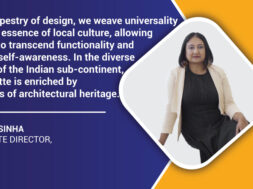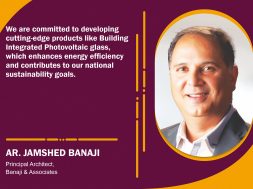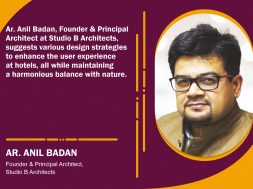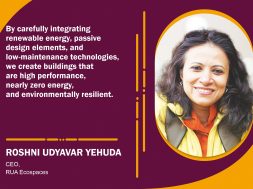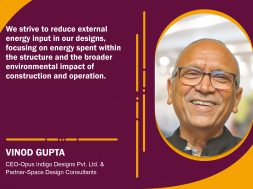Crafting the future of desi architecture
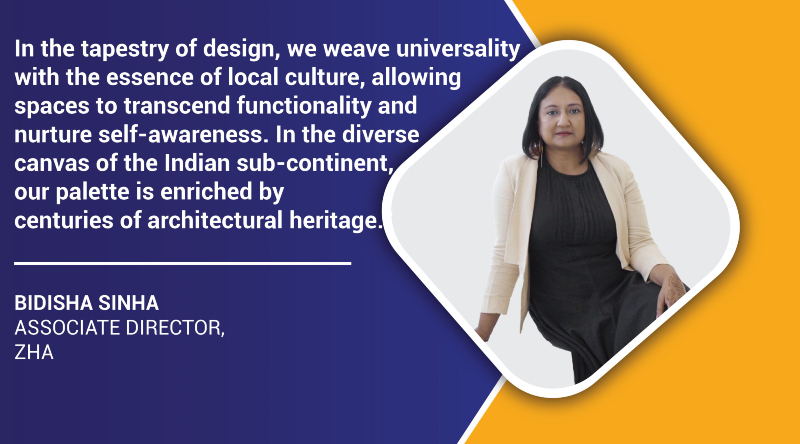
Delving into the innovative world of architecture, we have the privilege of gaining insights from Bidisha Sinha, Associate Director at Zaha Hadid Architects (ZHA). With a profound understanding of the intricate balance between tradition and modernity in architecture, Bidisha sheds light on recent projects, sustainability, cultural integration, and the future of Indian architecture.
Can you describe one of your recent projects that you feel represents a significant contribution to Indian architecture?
The most recent project that ZHA has been involved in is the Navi-Mumbai Airport. This new airport is being designed on a greenfield site to address the increasing need for passenger services in the Mumbai region, serving up to 90 million passengers annually. Designed to be an iconic addition to the legacy of architecture in the region, the terminal design is inspired by the national flower – the LOTUS, a symbol within ancient philosophy as the point of creation. In this light, the airport will become Mumbai’s beacon to the international world, representing the prestige it commands within the region and the wider global markets, blending modernity with the ethos of Indian culture.
Sustainability and climate responsiveness are crucial considerations in today’s architectural practice. How do you integrate these principles into your projects?
The new targets on building energy consumption proposed by governments worldwide encourage architects to design low-energy-demand buildings targeting “Net Zero.” This is achievable when we combine strategies for energy demand reduction through passive design, energy from renewables on-site, and carbon offsets. At ZHA, our approach to sustainability has always been implicit within our conceptual approach to all our projects. This begins at the site planning level right through to the choice of materials to reduce the CO2 emissions associated with construction and building usage throughout its lifetime.
At ZHA, we have a dedicated sustainability team that works with the project teams from the design mobilisation stage. Environmental variables-based rendering tools have been developed in-house to help in the realistic simulation of the internal spaces, including light value maps. For example, solar glare and exposure analysis are useful in developing workspace design or retail projects where local codes drive environmental performance.
India is a diverse country with various regional architectural styles. How do you navigate the challenges of designing buildings that resonate with the local context while maintaining global appeal?
Good design solutions have a universal appeal as they resonate with the core of how humans experience our surroundings. At ZHA, we work worldwide, responding to local cultures, climates, technologies, and procurement routes. Our success in navigating through these variables and providing a fit-for-purpose solution begins with understanding, first and foremost, the context of the projects and bringing to this our experience of design excellence. We approach projects with the understanding that any space’s design needs to be functional and bring to the user a new experience and self-awareness, allowing them to be their true selves. In the context of the Indian sub-continent, which has a rich history of architecture influenced by diverse cultures over the centuries, the palette available to work with makes the process even more enriching.
In your opinion, how has technology influenced the evolution of Indian architecture?
Technology is the precursor to the imagination of design at any scale, whether it be a city masterplan due to advances in infrastructure or an intimate classroom where the mode of instruction has fundamentally shifted. In the last decades, India has mirrored and adopted international styles and trends in architectural advances. However, the current trend is exciting, which has seen a large resurgence of using indigenous materials and traditional architectural elements with modern functionality. It is giving rise to a design language which is very unique to the region.
At ZHA, we have always embraced technology as a tool to push the limits of excellence outward. This is fundamental to sustaining the spirit of innovation. Our computational design team is dedicated to advancing research on advanced fabrication techniques to allow us to work with a wide range of new materials. Combined with our analytics & insights team, who can analyse programmatic efficiencies, our project teams can develop designs completely bespoke to the brief and local context.
How do you foresee the future of Indian architecture regarding sustainable practices, urban planning, and the fusion of tradition and modernity?
Fusing tradition with modernity has always been within the Indian architectural vocabulary. The country is unique in that, at any given moment, it is home to a very diverse culture and different economic profiles. The challenge of designing for the continuing growth of the urban landscape is an ongoing task supported by the advancement in technology emerging both from local and international agencies. The future of Indian architecture is now and only getting more robust, with small and large practices globally contributing to the conversation. At ZHA, we are also excited by the emerging prospects within the region and hope to realise a lot more of our projects in the coming years.
For more info: https://www.zaha-hadid.com/
100
Cookie Consent
We use cookies to personalize your experience. By continuing to visit this website you agree to our Terms & Conditions, Privacy Policy and Cookie Policy.
